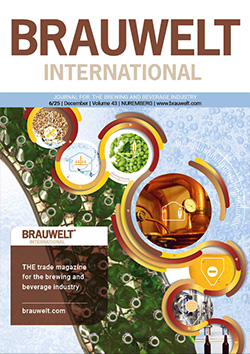BRAUWELT International 6-2025
EDITORIAL
KNOWLEDGE
INTERVIEW
OVER A PINT AT THE MAGPIE & MARTEN
MANAGEMENT
BEER AND BREWING HISTORY
EVENTS
EDITORIAL - Onward and upward to new horizons
Beer sales are declining around the globe. Many craft brewers who had pinned their hopes on steady growth are now faced with the challenge of rethinking their existing concept and have resigned themselves to exploring unchartered territories in the market. But, what else can a brewery produce besides beer? Are there other beverages beyond non-alcoholic beer and soft drinks? And above all, what do consumers want? We address these questions in a two-part article entitled “Alternative beverages for breweries.” The first installment, on p. 329, surveys the various avenues for creating sour-fermented beverages.
IN A HAZE OF VERY LITTLE ALCOHOL – Regarding the sensory quality of non-alcoholic and low-alcohol beers, consumers have the same high expectations for them as they do for conventional beers. After all, consuming non-alcoholic beer should not require sacrifice. To achieve a typical beer flavor profile, beer made using different production techniques are often blended together; however, this can result in issues with haze stability. Additional costs resulting from treatment with PVPP can be minimized through targeted stabilization of the beer produced using interrupted fermentation, as will soon be clear upon reading the article on p. 348.
FIT AND FUNCTIONAL YEAST – Whether it is employed to produce non-alcoholic beverages or those with alcohol, the yeast must be in excellent physiological condition. If this is not the case, the consequences are often negative. Good yeast physiology makes a key contribution to foam formation and head retention as well as to the flavor stability of the finished beer. Find out more about this fascinating topic on p. 344. The authors at the Research Center Weihenstephan have demonstrated a connection between fluctuating yeast quality – observed in samples they collected in daily brewing operations – and how these changes in yeast quality can impact the finished beer. They strongly recommend that the yeast quality be monitored on a regular basis and share simple, practical methods for doing so.
STEAMING COOLSHIPS – These vessels have a long tradition in breweries – that is, until they were arrogated to the fringes by modern technology. Nevertheless, they can still perform their intended function very well today, provided they are fabricated correctly. Nancy and Christopher McGreger take us back to the Magpie & Marten for a beer, where they discuss the most important aspects of the construction and use of coolships in “Ships passing in and out of the dim veil of history” (p. 342).
A GRAIN OF TRUTH ON FEMININE SUCCESS – Speaking of new horizons, the family-owned company Weyermann® Malz GmbH & Co. KG celebrated an extraordinary double anniversary on October 1, 2025. Sabine Weyermann marked 40 years as managing director, while her daughter Franziska Weyermann celebrated 15 years with the company. In a joint interview, the two women describe how they have experienced and shaped their roles in the malting industry (p. 332).
And before we dive into 2026, let’s take a quick look back at 2025, the year that was. On p. 354, you will see our double-page recap of events with pictures, all of which took place in the international brewing industry over the past year. This is just a smattering of the many events you’ll find at brauwelt.com in the media library.


